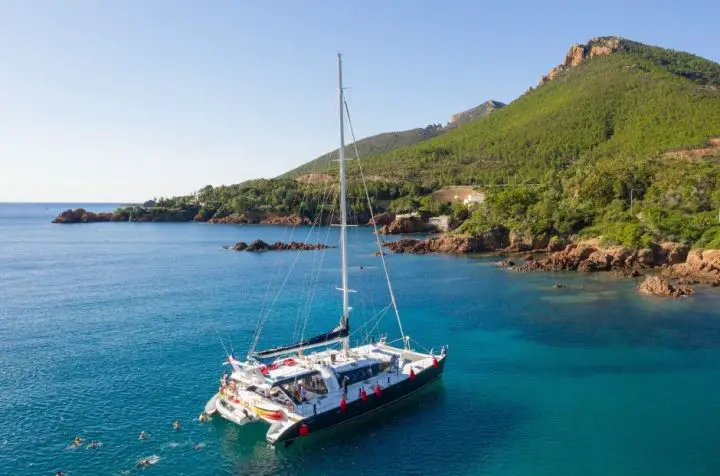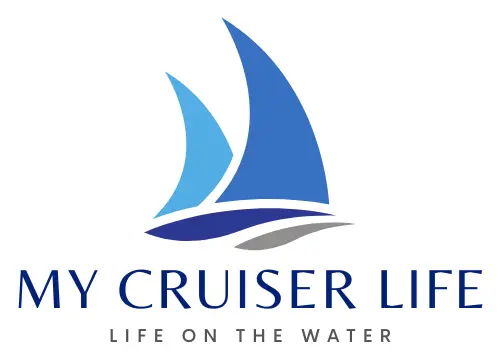A catamaran with cabin offers the perfect blend of adventure and comfort on the water. It delivers unmatched stability compared to traditional monohull yachts, reducing seasickness and creating ideal conditions for overnight stays. From weekend family getaways to blue-water sailing adventures, a catamaran with cabin combines marine comfort with exceptional performance. Let’s explore everything you need to know about these remarkable vessels.

Table of Contents
- Why Choose a Catamaran with a Cabin?
- Types of Catamarans with Cabins
- Top Features to Look for
- Best Models
- Cost of Owning a Catamaran with a Cabin
- Buying vs. Renting
- Tips for Sailing and Living
- Your Next Adventure Awaits!
- FAQs
Why Choose a Catamaran with a Cabin?
Catamarans with cabins offer unmatched stability thanks to their dual-hull design, creating a smooth sailing experience that’s perfect for family trips and extended voyages. The minimal rocking means less seasickness, which is a game-changer during longer journeys.
The cabin itself transforms your boating experience, providing essential shelter from harsh sun, unexpected rain, or chilly winds. This protection isn’t just about comfort—it’s what makes the liveaboard lifestyle and ocean crossings possible. With enclosed space for provisions, navigation equipment, and comfortable living areas, you can stay at sea for weeks or even months.
For families, the spacious layout of luxury catamarans provides valuable privacy that’s hard to find on other vessels. The wider beam creates generous living quarters where everyone can have their own space without constantly bumping into each other.
Types of Catamarans with Cabins
Sailing Catamarans
Sailing cats from brands like Lagoon, Fountaine Pajot, and Leopard range from cozy 35-footers to luxurious 60+ footers. With good wind and solar panels, you can cruise for weeks without using fuel. The best part? No more heeling over like on a monohull – everyone stays comfortable even at speed.
Power Catamarans
Not into managing sails? Power cats from Aquila and Leopard offer better fuel efficiency than similar-sized powerboats. Their flybridge helms give you incredible visibility that’ll spoil you forever – like going from tunnel vision to panoramic views.
Compact Cruisers
Brands like Gemini and Seawind offer smaller cats (around 30 feet) that won’t break the bank. These clever designs maximize space for weekend getaways and can be surprisingly zippy thanks to their lighter weight.
Luxury Catamarans
At the high end, Sunreef and HH Catamarans create floating palaces with multiple levels, jacuzzis, and magazine-worthy interiors. Many use carbon fiber for better performance despite its luxurious features. Just brace yourself for those seven-figure price tags!
Related: Exploring the 8 Biggest Catamarans for the Ultra-Wealthy
Top Features to Look for
When shopping for your dream cabin catamaran, certain features can truly transform your on-water experience. Here’s what seasoned cruisers prioritize:
- Sleeping Quarters (Berths) – Look for queen-sized island beds you can access from both sides and sufficient headroom throughout. The best catamarans offer clever storage solutions under berths for extended journeys.
- Galley (Kitchen) – U-shaped designs with three-point bracing keep you secure while cooking underway. Counter space disappears quickly, so prioritize layouts with ample prep areas. Top-loading fridges beat drawer-style options for efficiency during longer cruises.
- Head (Bathroom) – Separate shower stalls prevent the dreaded “everything gets soaked” situation. Proper ventilation prevents mildew, and adequate hot water capacity becomes crucial when hosting friends aboard.
- Saloon (Main Living Area) – The heart of your floating home should feature seamless indoor/outdoor flow to the cockpit. Wraparound windows bring the outside in, while thoughtful storage solutions throughout make the difference between a cramped catamaran and one that feels surprisingly spacious.
Best Models
Lagoon
- Lagoon 42
- Perfect balance of performance and livability
- Integrated salon-to-cockpit design
- Optimized helm position for single-handed sailing
- Lagoon 50
- Forward cockpit lounge for additional entertaining space
- Generous owner’s suite with private access
- Superior natural light through wraparound windows
Leopard
- Leopard 45
- Signature forward door system connecting salon to foredeck
- Enhanced natural ventilation throughout
- Raised helm station with excellent visibility
- Leopard 50
- Protected helm design for all-weather sailing
- Spacious flybridge with secondary control station
- Oversized aft platform for water access
Fountaine Pajot
- Lucia 40
- Impressive interior volume despite modest footprint
- Ergonomic galley design with ample counter space
- Optimal weight distribution for improved performance
- Elba 45
- Substantial flybridge with comprehensive visibility
- Lounge-style cockpit seating for 8+ guests
- Dedicated owner’s hull with private suite amenities
Bali Catamarans
- Bali 4.2
- Solid foredeck replacing traditional trampolines
- Forward cockpit with direct cabin access
- Fold-down bulkhead opening salon to cockpit
- Bali 5.4
- Hydraulic tilting door system combining indoor/outdoor spaces
- Spacious flybridge with summer kitchen
- Expansive owner’s suite with panoramic views
Related: What to Wear on a Catamaran
Cost of Owning a Catamaran with a Cabin
Purchase Price Reality Check
New cabin catamarans range from $300,000 for compact models to $1.5M+ for luxury vessels. Mid-range 40-45 footers typically cost $500,000-$800,000 – approximately double comparable monohulls. Financing options include 20-year boat loans at 5-7% interest with 20% down payments. Consider pre-owned vessels to avoid steep first-year depreciation.
Annual Operating Costs
Budget 2-5% of your vessel’s value annually for maintenance. Insurance ranges from $5,000-$15,000 for a $500,000 catamaran, varying by cruising area. Due to beam-based pricing, Marina fees can exceed $3,000 monthly for premium locations, while mooring balls offer more affordable alternatives at $200-600 monthly.
Hidden Costs
Multi-hull equipment and services command premium pricing. Dual engines require twice the maintenance, while energy systems for extended cruising (solar arrays, lithium batteries, water makers) can add $20,000-$40,000 to setup costs.
Cost-Effective Ownership Strategies
Consider fractional ownership or seasonal charter arrangements to offset expenses. Charter management can generate $30,000-$60,000 annually with tax advantages. Developing DIY maintenance skills significantly reduces service costs while building self-reliance essential for remote cruising.
Buying vs. Renting
The decision between buying or chartering a cabin catamaran depends on your sailing frequency and financial situation. Yacht charters through companies like The Moorings provide flexibility to explore different destinations without a long-term commitment. A weekly rental costs approximately $5,000-$8,000 for a 40-foot cabin catamaran – substantially less than ownership costs for occasional sailors.
Ownership becomes financially viable when you’re spending more than 8-10 weeks annually on the water. The break-even point typically occurs around 60-70 sailing days per year. Many owners offset costs through charter management programs, which can cover 60-70% of expenses while providing tax benefits through depreciation.
For those seeking a middle ground, shared ownership options through SailTime or private partnerships divide expenses while guaranteeing usage periods. A quarter share in a 45-foot catamaran might cost $150,000 plus $12,000-$18,000 annually in maintenance fees.
Tips for Sailing and Living
Pros:
- Exceptional stability with minimal rocking compared to monohulls
- Spacious living areas with room for proper storage solutions
- Shallow draft allows access to secluded anchorages and beaches
- Superior natural ventilation through multiple hatches and ports
- Dual engines provide redundancy and improved maneuverability
- Greater energy generation potential with larger roof space for solar panels
- Dedicated spaces for privacy when sailing with family or friends
- Less heeling means more comfortable cooking and sleeping underway
- Enhanced safety with multiple hulls providing redundancy
Cons:
- Higher maintenance costs with duplicate systems (engines, rigging)
- Increased marina fees due to wider beam (often charged by total width)
- More challenging to sail single-handed than comparable monohulls
- Less responsive in light wind conditions due to greater weight
- More complex anchoring setups required for proper holding
- Limited availability of catamaran-specific repair facilities worldwide
- Higher initial purchase price compared to equivalent-sized monohulls
- Trickier to navigate in tight marina spaces, especially for beginners
- More vulnerable to cross-winds when docking
Your Next Adventure Awaits!
Choosing a catamaran with a cabin gives you the best of both worlds – exceptional stability and comfortable living space. These twin-hull vessels eliminate excessive rocking, making them perfect for families and anyone who gets seasick. With options ranging from compact to luxurious, there’s a catamaran for every budget. Yes, they cost more upfront, but the extra space, safety features, and access to shallow-water destinations make it worth it. For weekend getaways or longer voyages, a cabin catamaran delivers the perfect blend of adventure and comfort.
FAQs
Does a catamaran have a cabin?
Yes, many catamarans have cabins, though not all. Cabin catamarans range from compact cruisers to luxury yachts with multiple staterooms. The twin-hull design creates spacious living areas below the deck, offering more room than similarly-sized monohulls. Cabin configurations typically include sleeping quarters, a galley, head facilities, and a comfortable saloon for relaxing and dining.
What is the smallest catamaran with cabin?
The smallest catamarans with cabins typically start around 24-30 feet in length. Models like the Seawind 24, Catalac 8M, and Gemini 105M represent compact options with basic amenities. These smaller cabin catamarans offer enclosed sleeping space, minimal galley facilities, and modest seating areas, making them suitable for weekend trips while remaining trailerable and more affordable than their larger counterparts.
What are the downsides to a catamaran?
Catamarans have several drawbacks despite their popularity. Higher purchase prices and maintenance costs top the list, with duplicate systems requiring more upkeep. Marina fees are often doubled due to their wider beam. They’re less responsive in light winds and more affected by cross-winds when docking. Their size makes them challenging to maneuver in tight spaces and limits repair facility options worldwide.
Can you sleep on a catamaran?
Absolutely! Sleeping accommodations are one of the major advantages of cabin catamarans. Most models offer multiple private berths, often with island-style queen beds in owner versions. The stable platform virtually eliminates the uncomfortable heeling experienced on monohulls, ensuring a peaceful night’s rest even at anchor. Larger models feature luxurious staterooms with ensuite bathrooms comparable to upscale hotel rooms.
